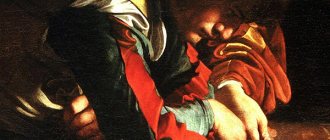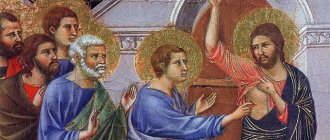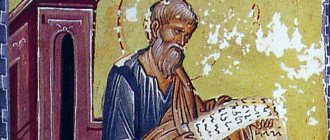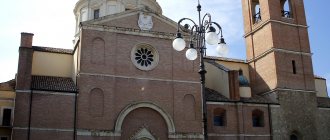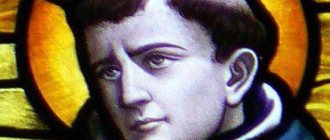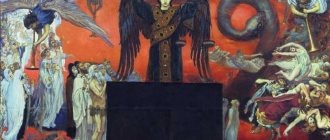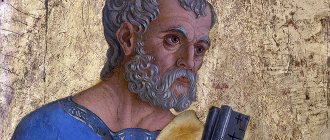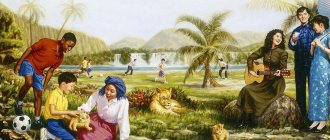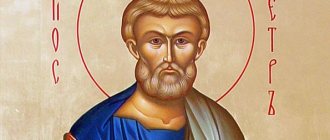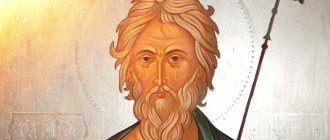Caravaggio - the greatest master of the Baroque era
Details Category: Fine arts and architecture of the late 16th-18th centuries Published 02/03/2017 13:38
He created his own artistic style - Caravaggism; in his paintings and in life he was distinguished by extraordinary energy. Having no teachers in painting, he became the greatest artist of his time...
The Italian artist Michelangelo Merisi da Caravaggio (1571-1610) became simply Caravaggio after his birthplace in the town of Caravaggio near Milan. This was the case with Veronese, Correggio and other Italian artists of the time, who received nicknames based on their place of birth.
The artist's life path
Ottavio Leoni “Portrait of Caravaggio” (1621)
Caravaggio was a simple mason. He lost his father early (the future artist was only 5 years old). His father served as manager for the Marquis Francesco Sforza da Caravaggio. Perhaps this is why Caravaggio had quite influential patrons, the first of whom were the Duke and Duchess of Colonna. Colonna , Roman family - an ancient Italian surname. The family still exists. And Caravaggio’s patrons were very necessary, because... he was distinguished by a violent temperament, a hot-tempered character, his life was constantly overshadowed by scandals, fights and imprisonment. In 1591, he was forced to flee Milan after a quarrel over a card game that ended in murder. First, Caravaggio went to Venice, then to Rome, then again there was prison - and so, in constant changes of circumstances and place of residence, his whole life passed. At the same time, he worked a lot, received orders from influential persons of that time, met under various circumstances with outstanding personalities of his time: in d'Arpino's workshop he met patrons of the arts and artists, in particular, Jan Brueghel the Elder; in Tor di Nona prison, where he ended up after another fight, he meets Giordano Bruno; in the fall of 1594, he begins to work for Cardinal Francesco del Monte, moves to his Villa Madama and meets here with the Italian physicist, mechanic, astronomer, philosopher and mathematician, who had a significant influence on the science of his time - Galileo; Italian philosopher and writer, one of the first representatives of utopian socialism - Campanella; Italian architect and sculptor Giacomo della Porta, poets Marino and Milesi. In 1606, a dispute on a ball court escalated into a fight, during which Ranuccio Tomassoni was killed. Caravaggio was accused of murder. The artist was declared “outlaw”; now anyone could kill him and even receive a reward for it - he was again hiding in the Colonna estate. In 1610, during his next adventure wanderings and while awaiting pardon from Pope Paul V, he died in Porto Ercole. On July 31, 1610, a papal decree pardoning Caravaggio was promulgated in Rome and a notice of his death was published.
Links
- The Incredulity of Saint Thomas
| Paintings by Caravaggio | |
| |
Creativity of Caravaggio
Caravaggio's first Milanese works have not survived. And the first painting that has survived to this day was “A Boy Peeling Fruit” (1593). There are two versions of this painting - 1592 and 1593.
Caravaggio "Boy Peeling Fruit" (1592)
Soon, Caravaggio created multi-figure paintings: “Sharpies”, “Fortune Teller”.
Caravaggio "Rounders" (1594)
Caravaggio "The Musicians" (1595). Canvas, oil. 92x118.5 cm. Metropolitan Museum of Art. New York, USA)
The painting was created to decorate the office of one of the first patrons of the young Caravaggio, Cardinal Francesco del Monte. The musicians are preparing for rehearsal. One tightens the strings of the lute, the violinist carefully peers at the notes, the third with a horn is Caravaggio, this is a kind of self-portrait. On the left is Cupid with arrows behind his back, busy with grapes. There are several titles for this picture: “Music”, “Musicians”, “Concert”, although a more suitable name is “Rehearsal”. At the same time as “The Musicians,” Caravaggio also wrote “Young Man with a Lute.” This picture exists in three versions. One of them is in the Hermitage.
Caravaggio "The Lute Player" (c. 1596). Canvas, oil. 94x119 cm. Hermitage (St. Petersburg)
It is believed that the artist’s favorite, Mario Minniti, posed for this painting (as well as for several others). Caravaggio himself considered The Lute Player his most successful image. All three versions of the painting show a very young man, almost a boy, with soft features and thick brown hair, accompanying himself on the lute. Caravaggio accurately conveyed the effect of the mutual influence of illuminated objects: the reflection of his white shirt falls on the lutenist’s cheek, and the light from the pages of a music notebook falls on the back of the lute.
Caravaggism
Caravaggio was one of the first to use the chiaroscuro style of painting - a sharp contrast of light and shadow. The artist was the founder of this style of European painting of the Baroque era. Caravaggism is characterized by an interest in accurately conveying the features of nature and emphasized realism in the depiction of objects. An important role is given to light and shadow, which help create volume: figures are placed in the foreground, their lighting is contrasting (for example, a dark room and a ray of light in it, illuminating the faces and figures of the characters in the picture). The largest representatives of Caravaggism are O. Gentileschi and M. De Fiori in Italy; “Utrecht Caravaggists” (D. Baburen, H. Terbruggen, etc.) in the Netherlands; H. Ribera in Spain. P. P. Rubens, D. Velazquez, Rembrandt, J. de La Tour went through the stage of Caravaggism.
Paintings on biblical scenes
Paintings of biblical subjects brought Caravaggio real fame, although some of them were rejected by the clergy.
Caravaggio "Rest on the Flight into Egypt" (c. 1597). Canvas, oil. 133.5x166.5 cm. Doria Pamphili Gallery (Rome)
The Holy Family was tired on the way to Egypt - the Virgin Mary and the baby fell asleep to the music of an angel, and Joseph held the notes. The light-air environment creates an atmosphere of poetry and peace. A modest landscape complements the picture, but it is rather a Lombard landscape dear to the artist’s heart, rather than a Middle Eastern one. The paintings “The Ecstasy of St. Francis" (1595), "Sacrifice of Isaac" (1598), "Penitent Mary Magdalene" (1597), "Saint Catherine of Alexandria" (1598), "Martha and Mary" (1598), "John the Baptist" (1598), " David and Goliath" (1599), "The Calling of the Apostle Matthew" (c. 1600), "The Martyrdom of St. Matthew" (c. 1600), "The Conversion of Saul" (1600), "The Crucifixion of St. Peter" (1601), "The Unbelief of the Apostle Thomas" (1600-1602), "The Kiss of Judas" (1602), etc.
Caravaggio "The Calling of the Apostle Matthew." Canvas, oil. 322x340 cm. San Luigi dei Francesi (Rome)
Caravaggio painted this painting for the Contarelli Chapel in the Roman Church of San Luigi dei Francesi. The plot of the picture is taken from the Gospel of Matthew - Jesus saw the tax collector Levi (Matthew) at the gates of Capernaum and called him to apostolic service: “...Jesus saw a man sitting at the collection office, named Matthew, and said to him: follow Me. And he arose and followed Him.” Caravaggio depicted this plot as a scene from contemporary life. In the shadows at the table, the publican (tax collector) Levi is counting the revenue, assisted by an old man in glasses. The armed guards turned their heads towards the new arrivals. The publican's clothing indicates his condition. Of all those present, only Levi understood who was standing in front of him. In amazement, he points questioningly at himself, waiting for confirmation. A stream of light falling from the side where Jesus and the Apostle Peter stand breaks through the darkness. It symbolizes the light of faith that burst into the vain, vain world of Levi. The figure of Jesus is almost completely covered by Peter - only his head and hand are clearly highlighted against a dark background.
Caravaggio "Entombment" (1603)
Caravaggio’s visual language was clear even to an unprepared viewer, so his paintings on biblical subjects did not require additional interpretation, which created enormous popularity for his paintings, although the clergy did not accept some of these paintings, for example, the painting “Entombment” and others.
Caravaggio "The Unbelief of Thomas the Apostle." Canvas, oil. 107x146 cm. Sanssouci (Potsdam, Germany)
The plot of the picture is taken from the Gospel of John. The Apostle Thomas was not present at the appearances of Christ after the resurrection and expressed doubts about the reliability of the stories of other disciples. He declared that he would believe only if he personally verified the presence of wounds on the body of the resurrected teacher. A week later, Thomas received this opportunity and, putting his fingers into the wound of Christ, believed. The figure of Christ on the left side of the painting is well illuminated by the light falling on the right side of His body and focuses on His open chest with a gaping wound. The bowed figures of the three apostles on the right side of the picture are also illuminated. The background is dark and undetailed, which is a characteristic feature of Caravaggio's style. Thomas’s surprised and incredulous gaze is directed at the wound on the chest of Jesus, who guides the apostle’s hand with his own hand. The close attention with which the two other apostles look at the body of Jesus is similar to the emotional reaction of Thomas, which indicates a non-trivial interpretation of the gospel plot: not only Thomas needs confirmation of the miracle. The absence of a halo above Jesus’ head suggests that he appears here in his bodily form.
Caravaggio "The Kiss of Judas". Canvas, oil. !33x169 cm. National Gallery of Ireland (Dublin)
The plot of the film is based on the messages of the evangelists about the last days of the earthly life of Jesus Christ. Judas Iscariot, one of Jesus' disciples, betrayed him by revealing his whereabouts and pointing him out to the guards when Christ was leaving the Garden of Gethsemane. All characters' faces are brightly lit. Jesus, who knew about Him who was betraying Him, seems to be trying to evade the treacherous kiss, but at the same time accepts it as inevitable. The guard's hand is already raised to take the betrayed Judas.
Caravaggio. On the run. Naples
Starting the next story, you need to make a small digression. They say, “As is the city, so are the citizens.” The Neapolitans live on a volcano, moreover, their character is of “volcanic origin”...
Mount Vesuvius is a stratovolcano in the Bay of Naples, Italy, approximately 9 kilometers east of the city, not far from the coast.
Vesuvius has erupted many times since then and is the only volcano on the European mainland that has been active for the last hundred years. Today it is regarded as one of the most dangerous volcanoes in the world due to the population of 3,000,000 people living nearby and its tendency to erupt violently. It is the most densely populated volcanic region in the world.
Sylvester Shchedrin (“Russian Neapolitan”). View of Naples. 1819. Quoted by P. P. Muratov, “Images of Italy.”
“Naples cannot be imagined without the classic panorama of mountains and sea. Her fabulous beauty entered deep into the people's soul. Nowhere will you see so many people staring at the world as you meet at every turn, which opens up an immense view of the city, Vesuvius and the bay. The Neapolitan is proud of this view as his best asset.”
Sylvester Shchedrin. Neapolitan embankment. 1829. “The line of the coast, smoothly running away to the dark groves of Sorrento, the subtle outlines of Capri and Ischia awaken in the soul an ancient, like light, memory of an earthly paradise.”
“Passion for the game and easy money, innocent depravity, the spirit of adventure, trade, noise, trickery, street fights - everything, in a word, with which the labyrinth of a huge city is now filled.
To understand local customs, it is interesting to see the small theaters scattered in the people's quarters. It all comes down to the highlights of the game that strike the hearts of viewers like lightning. When knives flash on stage and open with a dry crack, when the movement of a duel or murder flashes, well known to the Neapolitan crowd, the audience is completely delighted. Amid thunderous applause and cheers, the murdered man stands up, bows, takes his place, and the murder scene is repeated for the complete pleasure of the public.”
Sylvester Shchedrin. Neapolitan embankment. 1829.
After committing a murder (accidental - in a flash of anger), Caravaggio, , goes on the run. With the help of the Carafa-Colonna family, in October 1606 he moved to Naples, where he also developed interests. During the Neapolitan "exile" he finally begins to receive royalties for his paintings and is no longer forced to work in hiding. Some documents from that time confirm that Caravaggio had an account in one of the Neapolitan banks - a sign that his exile was not so disastrous, on the contrary, it was quite profitable.
Why? Naples is Caravaggio’s native element. If the Neapolitans are the concentration of the Italian temperament. Caravaggio is a concentrate of Neapolitan qualities, enhanced by the fact that as an artist he is undoubtedly a genius.
Naples. Pio Monte della Misericordia. Beginning of the 17th century. Built by the Naples Benevolent Society. The main treasure of the church is Caravaggio’s work: “The Seven Works of Mercy.”
The Neapolitan church of Pio Monte della Misericordia has gained worldwide fame thanks to the immortal work of the great Caravaggio - an altarpiece depicting the Seven Works of Mercy. The painting was painted by order of the charitable society Pio Monte della Misericordia, which at the very beginning of the 17th century decided to create a church glorifying the noble deeds of man (including this foundation). At first a modest church was built. Then it was expanded, making 7 chapels in it - in honor of the six Gospel commandments, adding another one to them - the burial of the dead.
Naples. Church of Pio Monte della Misericordia. The main hall is built according to the type of the Roman pantheon - it is a round space with a semblance of exedra. In the central exedra-altar there is a painting by Caravaggio...
“The work made a strong impression on the customers, and they vowed that henceforth this creation should not leave the main altar of the church at any cost. They also imposed a strict ban on copying it. The decision made in 1607 is still sacredly observed, despite all the subsequent vicissitudes associated with the ostracism of Caravaggio. Next to the painting, under glass, an agreement with the artist for its painting is displayed as a valuable relic, indicating the amount of the fee paid - four hundred and seventy gold crowns. The canvas never left its place at the main altar, even when in Rome many of Caravaggio’s works were taken out of churches and hidden in basements and attics.”
Caravaggio. "Seven Acts of Mercy" 1606-1607. From above, the Madonna and Child, supported by two Angels, look from Heaven at what is happening on earth. Below are the Seven Acts of Charity performed by the best of men... According to the Gospel, the Catholic Church lists six acts of mercy: 1. Feed the hungry. 2. Give drink to the thirsty. 3. Give shelter to a wanderer. 4. Clothe the naked. 5. Visit the sick person. 6. Visit a prisoner in prison. Added to them from the Old Testament 7. Bury the dead. Usually all the deeds were depicted in separate paintings, but Caravaggio was the first to create a complex composition by placing all the deeds in one picture. On the right is a scene in which, looking around in fear, a woman breastfeeds a prisoner in prison (Acts 1 and 6). Behind her, the gravediggers carry the deceased out of the house.
Caravaggio. "Seven Acts of Mercy" A fragment showing the remaining virtues. Moreover, the lower corner of the painting (the beggar on crutches) is poorly visible, since in his haste the artist did not allow the canvases to dry.
On the left in the lower level there is a scene of a young man cutting his cloak in two with a sword in order to give it to two beggars, one of them naked and the other sick, crutches are visible (4th and 5th acts). At the edge of the picture, the inn owner invites the wanderer to his place (3rd act). Behind them, the biblical Samson quenches his thirst from a donkey's jawbone (2nd act).
Caravaggio. "Seven Acts of Mercy" Fragment: The Madonna and Child look from Heaven at what is happening on earth.
Many people wrote about Caravaggio’s “criminality,” because it seemed natural and easy to explain the aesthetics of “tenebroso” by connecting it with the dark sides of his soul (Bellori: “His depth and background are always black” - and about Caravaggio himself: “He had a dark face , dark eyes, black eyebrows and hair"). Of course, of the three great innovators of Italian painting, Caravaggio seems to be an absolutely negative figure in moral terms - in contrast to Giotto, who can be assessed in this regard as an “average” personality (he sought to achieve a respectable position and acquire wealth) and Masaccio, a “positive” figure ( he was kind and selfless).
But the artist who painted such a Madonna and Child, and from the common people, cannot be accused of deep darkness of soul.
Caravaggio. "Seven Acts of Mercy" Fragment: gravediggers, lighting their path with a torch, carry the body of the deceased out of the house.
For me, it is more acceptable to consider what path Caravaggio went through as a person - from a carefree reveler to a philosopher trying to comprehend the mysteries of existence and the essence of human nature - sin and holiness.
I am drawn to his work because it encourages me to think about the meaning of human life, taken at the very edge of its brilliant possibilities.
I think that the fate of Caravaggio allows us to plunge into the problem of GENIUS and VICINITY, seeing in it revelations that cannot be found in other destinies.
Let's not go astray...
Caravaggio. "Madonna del Rosario" ("Madonna with the Rosary"). 1607. The painting was probably painted for the Church of San Domenico in Naples. Kept in the Kunsthistorisches Museum in Vienna.
In the pyramidal composition, three groups are easily distinguished, like three levels of involvement in the event. Below is a crowd of believers, people, people of low origin, among whom the painting’s customer is depicted, turning to the viewer. Above them are the Dominicans, mediators between the believers and the Madonna. Finally, at the top of the pyramid is the Madonna and Child. The diagonal running from this group to the Madonna ends with a curtain. Overall, this majestic composition is full of high nobility, it is expressive without pathos or rhetoric.
This painting once again convinces that, without changing his usual painting style, his themes and technical techniques, Caravaggio can create a “grand style” composition.
Caravaggio. “Madonna with the Rosary” (fragment). 1607. Vienna. Images of beggars - mother and baby...
In Madonna of the Rosary , Caravaggio praises not piety or reverence, but the genuine faith of the poor, expressing it in the trembling outstretched hands of the faithful crowding around the throne.
Caravaggio's religiosity corresponds to the purest religious movements of the time. Their adherents, under the threat of being accused of heresy, fought against the stubborn advance of the church and its political apparatus in the person of the Jesuits, strove for the spiritual unity of believers beyond hierarchical and class differences, for purity of faith and for effective mercy.
Caravaggio. “Madonna with the Rosary” (fragment). 1607. Vienna. Images of beggars begging the clergy for saving amulets - bone beads from rosaries...
There is no doubt that Caravaggio painted the picture from the bottom of his heart, in a moment of extraordinary spiritual clarity. In the sacristy of the inquisitor monks, he gathered the most amazing, most magnificently expressive beggars and depicted these unfortunates in tears, on their knees, with outstretched hands... They beg for poor amulets - bone beads, which should rescue them from poverty...
Standing above the beggars, the very gloomy and pathetic Dominicans saw in the expression of pure impulse only dirty, bare feet, which reduce the level of divinity of the painting they commissioned.
Caravaggio. "The Crucifixion of the Apostle Andrew." !607 year. The apotheosis of suffering for the Faith. In the depiction of the apostle's head, expression is brought to a grotesque point - a technique that will be developed by followers to the extreme degree of exaggeration.
The life and sufferings of the Holy Apostle Andrew the First-Called are told... “Saint Andrew went through cities and countries, preaching of Christ , and in each city he accepted many sorrows and sufferings... They threw him to the ground and, taking him by the arms and legs, dragged him, beat him with logs, threw him into they stoned him and pulled out his fingers and teeth; but he, by the grace of his Savior and Teacher, again found himself healthy and whole from his wounds.
The angry Egeat ordered Saint Andrew to be crucified on the cross, tying his hands and feet: for he did not want to nail him, so that he would not die soon and, hanging tied, would suffer more torment.
And Andrew said: “Receive me, Good Teacher, and no sooner command me to be taken down from the cross than you receive my spirit!” As he said this, a light from heaven shone around him and shone around him for half an hour, and when the light receded, the holy Apostle gave up his ghost and departed in the blaze of light to appear before the Lord.”
Caravaggio. “Taking Christ into custody” from the Museum of Western and Eastern Art in Odessa. 1600s.
The composition of the picture is based on a tense rhythm. It arises due to an arc that slopes smoothly to the left. This creates a sense of circular motion, which is one of Caravaggio's remarkable discoveries. The theme “Taking Christ into custody” was very popular among the artist’s followers.
I see the main thing differently: in this early, still Roman period painting, Caravaggio begins to develop the image of Christ, which in the Neapolitan period would become confessional...
Caravaggio. "The Crowning of Christ with a Crown of Thorns." 1600s. Vein. Museum of Art History. In the hands of Jesus, tied in front, is a reed scepter as a sign of mockery of Him as the King of the Jews.
Christ suffers, reproached because he wants to say a new word that helps people distinguish Good from Evil. They don’t understand him, they laugh at him, they humiliate him, they beat him up...
Caravaggio correlates all the subjects of his paintings with his own views. And he, like Christ, is the chosen one: capable of saying a new word. This New lies in the bringing together of the Divine and the human. His Jesus, the Mother of God and the apostles are people from the common people, like beggars and executioners. The division follows a different principle: some people defend Good, others commit Evil.
He, the artist, is being crucified unjustly, like Christ. This is one layer of the problem; there are others hiding underneath it.
Caravaggio. "The Flagellation of Christ Tied to a Column." 1606-1607. Museum in Rouen. The torso of Christ is depicted with remarkable anatomical accuracy - the fruit of observation and understanding of nature, truly worthy of admiration. Executioners are disgusting.
Caravaggio considered himself a GENIUS... And he was - he was a highly creatively gifted person, whose works are distinguished by exceptional novelty and originality, special historical significance for the development of human society, due to which they are forever preserved in people's memory.
The concept of GENIUS was formed in modern times (XVI - XVIII centuries) on the basis of ancient ideas about “genius” - “spirit”. In Plato’s “Symposium,” spirits-“daimons” are “the middle ground between god and mortal” and have the power “to be interpreters and transmitters of human affairs to the gods, and divine affairs to people, thanks to which the whole existence is linked together.
With the growth of individualism in new European culture, through the Renaissance idea of the deification of man, the idea of the artist as the “SECOND GOD” was established.
This is the second layer of the problem: the frantic Caravaggio felt like a GENIUS, which was equal to the “SECOND GOD.” Such a sense of self gave him the right not to obey church dogmas. And this happened in Papal Rome during the Inquisition...
Caravaggio. "The Flagellation of Christ". 1606 - 1607. National Museum and Gallery of Capodimonte, Naples. The faces of the executioners, distorted with bestial anger, and the use of gloomy colors enhance the feeling of horror of what is about to happen...
By 1604, Michelangelo Merisi da Caravaggio had become the most famous artist in Italy of his time, but not only that, he was also known as the most controversial artist, because heated debates always flared up around his paintings. The main thing is that Caravaggio’s name was also associated with notoriety. His name appeared more than 10 times on the list of those who broke the law with their careless antics. At the same time, he carried a bladed weapon without permission (a huge dagger on his belt) or a page carried a sword behind him.
They say that such behavior was caused by the fact that the artist throughout his life remained faithful to his convictions, internal independence, and perseverance in achieving his goals. A man of violent temperament, he aggravated his situation with his temper.
Do you want to add: he needed to relax after unbearable stress, so to restore balance he fell to the very bottom? I won’t accept such an excuse...
Caravaggio. "The Assurance of Thomas", 1600-1602. Sanssouci Palace, Potsdam, Germany. The appearance of Christ to His disciples after the Crucifixion is depicted.
"The Unbelief of Saint Thomas" is one of Caravaggio's recognized masterpieces. The compact composition concentrates the attention of the viewer, as well as the apostles, on the moment of physical proof of the miracle: Thomas puts his fingers into the wounds of Christ, making sure of his resurrection. Caravaggio depicts this moment objectively and simply, without the smack of smug realism, for which such a topic provided the opportunity.
Jesus came when the doors were locked, stood in the midst of the martyrs and said: “Peace be with you!” Then he says to Thomas: “Put your finger here and see My hands; give me your hand and place it in my side; and do not be an unbeliever, but a believer.” Thomas answered Him: “My Lord and my God!” Jesus said, “Because you have seen Me, you have believed; blessed are those who have not seen and yet believed!” (according to the Gospel of John).
Caravaggio. "Supper at Emmaus" 1606. Pinacoteca Brera, Milan.
Caravaggio turned to this gospel story again in 1606, while in exile. The characters' gestures are restrained, there are no bright spots, the artist's style has become more gloomy. The image of Christ is resolved less radically - now it resembles Christ from “The Last Supper” by Leonardo da Vinci .
After breaking bread, Christ conducts a conversation with his disciples. When complete, He will disappear and they will wait for His return. Wait... Wait... Wait...
Caravaggio. "Supper at Emmaus" 1606. Pinacoteca Brera, Milan. Fragments are portraits of an old woman and an old man.
The root of all the troubles of the brilliant Caravaggio, I think, was that HE BELIEVED IN HIS EXCLUSIVENESS, IN THAT HE IS A “SECOND GOD” AND THE WHOLE REST OF THE WORLD SHOULD FALL PROMISED BEFORE HIM.
For a creator, putting one’s own genius at the forefront is disastrous, inevitably disastrous. Such a sense of self was the CURSE OF MEDUSA - that heap of suicidal thoughts that swirled, hissing, around his head...
YOU ARE A GENIUS, EVERYONE ELSE IS NOTHING, SO YOU ARE ALLOWED EVERYTHING.
Caravaggio. "Saint Francis". 1606. In storage at the National Gallery of Old Art, Palazzo Barberini.
Francis is especially revered by the Catholic Church. The years of his life are 1181-1226. At that time, the monasteries owned large plots of land, the abbots became so rich that they were not inferior in luxury to princes and bishops. Francis spent his entire life developing the idea of poverty and calling on everyone to follow the poor and suffering Christ.
Caravaggio depicted the saint during his mystical reflections. Saint Francis is alone before the image of death. The picture is laconic: Francis, dressed in a worn cassock, looks thoughtfully at the skull - a symbol of death. The light falls on his strained, exhausted face. There are no unnecessary details in the picture, which emphasizes the moral greatness of the saint and the depth of his thoughts.
A picture that has not yet been painted - to paint it requires the highest spiritual insight, which is given only in torment...
I repeat... Caravaggio’s Neapolitan paintings contain life in its various manifestations and, most importantly, a reverent thirst for the miracle of renewal. And suddenly he runs again.
From whom? On his own?.. Or is someone driving him away?..
Sea - Eternity, breathing, living, attractive...
<- Caravaggio: After the “cry of Medusa” - Rome
Caravaggio: Falling into the abyss. Malta, Porto Ercole ->
